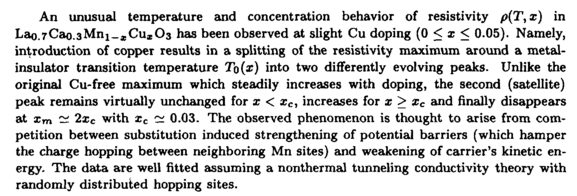Anomalous temperature behavior of resistivity in lightly doped manganites around a metal-insulator phase transition
Sergeenkov S., Ausloos M., Bougrine H., Rulmont A., Cloots R.
ID: 71.27.+a, 71.30.+h, 75.50.Cc
An unusual temperature and concentration behavior of resistivity p(T, x) in øÁÏ./óÁÏ.ÚíÐÈ-Ä.óÉÈïÚ has been observed at slight óÉ doping (0 < χ < 0.05). Namely, introduction of copper results in a splitting of the resistivity maximum around a metal-insulator transition temperature 7o(i) into two differently evolving peaks. Unlike the original óÉ-free maximum which steadily increases with doping, the second (satellite) peak remains virtually unchanged for χ < xc, increases for χ > xc and finally disappears at xm ~ 2xc with xc ~ 0.03. The observed phenomenon is thought to arise from competition between substitution induced strengthening of potential barriers (which hamper the charge hopping between neighboring Mn sites) and weakening of carrier's kinetic energy. The data are well fitted assuming a nonthermal tunneling conductivity theory with randomly distributed hopping sites.


 Home
Home